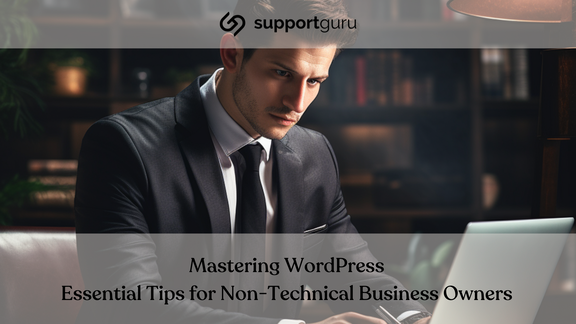Mastering WordPress may be overwhelming to a lot of business owners, that’s why they have a tech team. But what if we said there are other service providers who can guarantee better results at half the cost?
In order to better understand WordPress, it’s best to address each employee’s strong suit.
Client’s comfort zones depend heavily on whether they know the process of uploading files and using image editors.
A detrimental factor they should be aware of is the difference between posts, pages, widgets, short-codes, and other features that will/might be an add on.
Understanding the Dashboard
In order to best learn the basics, understanding the functions offered in the WordPress dashboard comes next.
Start by familiarizing yourself with the administrator toolbar, main navigation, work area, and widgets.
The dashboard includes the following:
- Welcome
- At a Glance
- Quick Draft
- Activity
- WordPress News
Page and Posts
WordPress supports multiple content types - pages and posts. Though they might sound similar, they are, in fact, different.
Posts are more dynamic entities that are listed in reverse chronological order. They are social and have options like social share buttons and comments.
Pages are more static. Examples of pages may be the ‘About Us’ page or landing pages.
Permalinks
The static URLs of the individual posts are named permalinks. Permalinks mean permanent links since the URL will not change.
In order to get access to the permalink settings page, do as follows:
Dashboard>Settings>Permalinks
Content Visibility
Content visibility allows you to decide who can see the pages or posts you publish. You are able to change the visibility settings from the edit screen
Multi-Paged Posts
A useful feature that allows you to publish long content on your website It allows for the opportunity to offer visitors the chance to read lengthy articles in a sequence of pages.
How to Customize WordPress
For non-technical users, customization is essential. It gives your site some unique qualities.
Customization may be applied through the use of plugins for greater features.
Plugins installed on your WordPress site should be thought of, whereas too many plugins added can do more harm than good.
Remember, it’s all about quality over quantity.
How to Optimize Posts on WordPress
Adding media files, categorizing posts, and creating feature posts all fall under optimizing posts.
Not to mention, optimizing your posts helps boost search engine rankings on SERPs.
Category and Tags
Categories help with grouping. This option can be found on the right side of the edit screen.
WordPress also allows you to add different tags to further categorize or group blog posts.
Featured Images
Selecting a featured image to represent a blog post is the next step. Ideally, you can use landscape resolution for the featured image.
Uploading a high resolution, compressed image can elevate the reader's experience.
Instaling Plugins
As mentioned before, plugins add various functionalities to a website. Accessing the plugins page from the dashboard menu will present all the plugins installed on your website.
Each listing has options such as deactivation, editing, deleting, and so on.
If a plugin needs to be updated, you can do so by navigating to the menu.
Understanding User Roles
Setting up permissions for each user is important since if one user is unsure of how to use specific aspects, more mistakes are likely to happen.
WordPress supports the following user roles:
Administrator: Users with full privileges on the website.
Editor: Users who can publish and manage posts that include posts of other users.
Author: Users who can publish and manage their own posts.
Contributor: Users who can create posts but can’t publish them.
Subscriber: Users who can manage only their profile.
Super Admin: Users with full privileges on your website network.
Updating WordPress
Updating is a necessary step in WordPress, and whether or not you have tech-know-how, it is vital that this step be ingrained.
Failing to update your WordPress site may leave it open for possible site hacks or malware breaches.
In order to update your WordPress site, ensure that you begin by backing up your website, this ensures that you won’t lose any important details.
Once backed up, you can access the updates page by clicking on the update option in the admin panel menu.
If a new version is available, you will be able to find an Update Now button.
